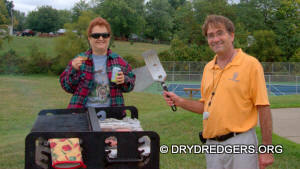
It was cold and windy with an intermittent light drizzle of rain when the Dry Dredgers gathered with the Kentucky Paleontological Society for a picnic at Richardson Road Park in Kenton County, Kentucky. We had about 40 people for a grill-out and social time.
More picnic pics from Dawn Kincaid
Site#1: Latonia (Kope) Formation
After the cookout, we caravaned to our first site, a hill cut exposing the Kope Formation. Bill Heimbrock provided a very nice (if I must say so myself) field guidebook describing the sites and identifying the fossils that can be found using pictures. Here are some shots of the fossil finding fun at the first site.
Cephalopods (Kope Formation)
The best fossil find from the first site was this beautiful
coiled nautiloid cephalopod, which appears to be Trocholites sp..
Very nice! Congrats!

Often we know to examine a specimen before we pull it from the
ground. Important information can be gained by examining photos and notes. In
this case, it was useful to find the direction it was pointing so we know how to
pull it out safely and get all the pieces. This specimen looked very interesting
sticking out of the ground. After it was extracted, the dirt was left on it to
preserve tiny fragments that would otherwise be lost. This specimen is a
siphuncle of orthocone nautiloid cephalopod. (next 2 pics.)
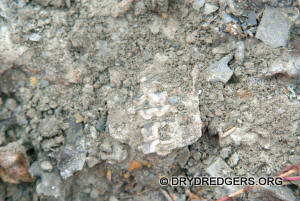
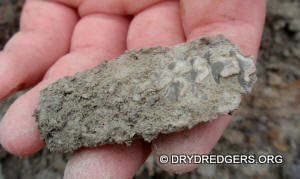
We found lots and lots of nautiloid cephalopods on site #1.
Most of them had a light brown calcite preservation. This reveals exquisite
detail, as you can see in these photos. (8 photos)



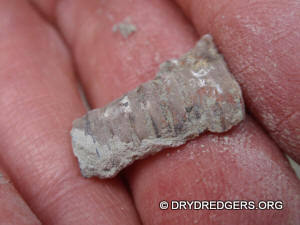




"Black Marks" On Rocks and Fossils (Kope Formation)
Black marks on Ordovician rocks can be a mystery. The ones found at site#1 are well known, but require more professional study.
We found some "black squiggles" on a bryozoan that are
actually the remains of worm tubes. They were originally thought to be part of
Sphenothallus but are still under study by the
paleontological community.

Well known are the Graptolites ("writing on rocks"). We found
black markings on shale fragments that were clearly the graptolite
Geniculograptus typicalis.



Trilobites (Kope Formation)
Only fragments of trilobites were found on site#1. The site is old and heavily weathered. Whole trilobite fossils do not stay together long once on the surface.
Cryptolithus bellulus (Lace Collar) Trilobite fragments.
Isotelus sp. Hypostome (mouth plate)
Crinoids (Kope Formation)
Brachiopods (Kope Formation)
This is probably Vinlandostrophia hopensis.

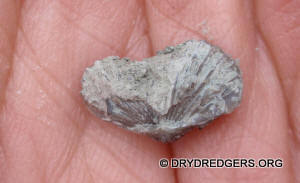
Bryozoans (Kope Formation)
Here's a button shaped bryozoan preserving the shale under it.
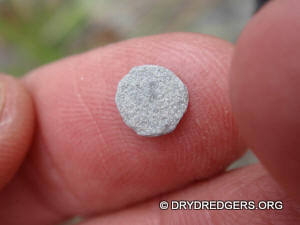
With the same shape as the above are these cross sections of a
pyrite-filled burrow that was part of a nodule.

You should note that these disc-shaped fossils are sometimes chamber fillings of
nautiloid cephalopods, as was true on the
October 2014 field trip to a Whitewater Formation site.
Thanks to Dawn Kincaid for this photo of a cluster of annelid worm
tubes (probably a Cornulites sp.) attaching to
crinoid stems. It was found by Doris Burton.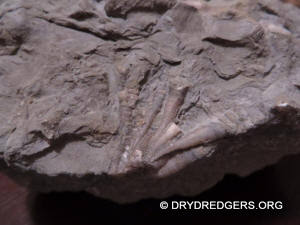
Site #2: McMillan Formation
After an hour and a half at the first fossil site, we moved on to the second site in the field guidebook. This is a gentle slop along a road in Northern Kentucky that exposes the Maysvillian Stage of the Cincinnatian Series. The fossils were alive during the late Ordovician Period, 445 million years ago.
A hand lens discovered many more exciting fossils than were
visible with the naked eye.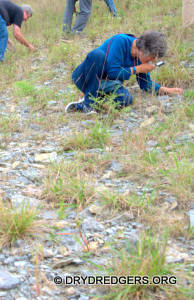
A surprising number of people brought their cameras and
documented their fossil finds. 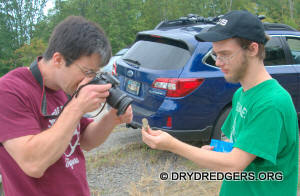
Fossils Found at Site #2 (McMillan Formation)
Trilobites (McMillan Formation)
The best fossil find from site#2 was this trilobite glabella.
It looks like a Flexicalymene sp., doesn't it? Nope!
This might be something much more rare. Note the small bumps in the enlarged photo and
then notice the larger, less frequent bumps. This is probably not the bumpy
F. granulosa we know from the Kope Formation.
The correct identification is now being investigated by an expert trilobite
worker. Congrats to the person who found this. WHO FOUND THIS?
Can you please email me at
billheim@cinci.rr.com and let me know if you have it? You are one lucky
fossil hunter!
(I'll admit, I was photographing the rock and not paying
attention to who handed it to me. And my glasses were too greasy from grilling
hamburgers to see these tiny bumps.)
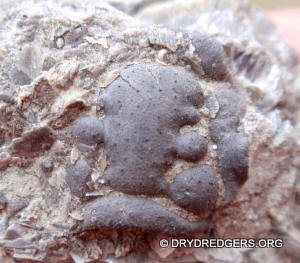
One nearly perfect enrolled Flexicalyemene meeki was found.
Note the somewhat sharp genal spine which helps
identify this Maysvillian Stage species.


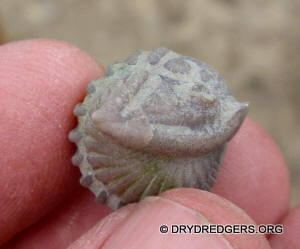
Here's a nice partial
prone Flexi that was found.
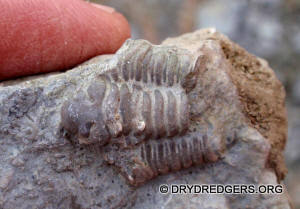
And do you recognize this shape? If so, you may be a Trilobite hunter. It's the distinct cross-section of a thorax segment of a trilobite. This one is from a Flexicalymene meeki.
Trilobite fragments of Isotelus sp.
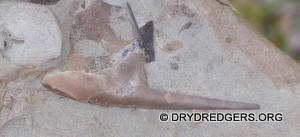
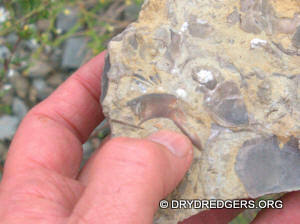
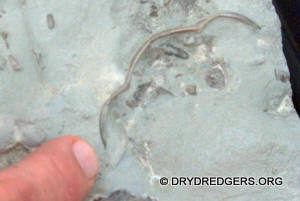
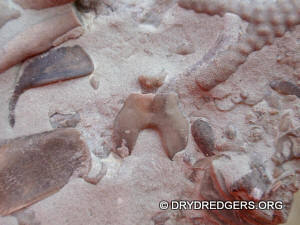

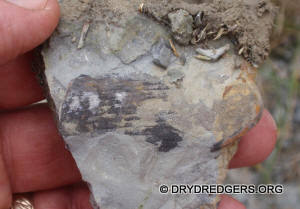

Here's a trilobite fragment that is unidentified. It could be
a common Flexicalymene sp. glabella, but probably not.
More info on this to follow...
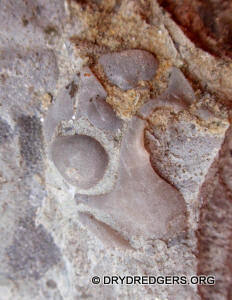
Crinoids (McMillan Formation)
We think this is a crinoid calyx (cup) plate of a Pycnocrinus dyeri.

This second site was great for crinoid holdfasts. Here's a
few. The first three pics are podolith holdfasts apparently from the crinoid
Anomalocrinus incurvus.
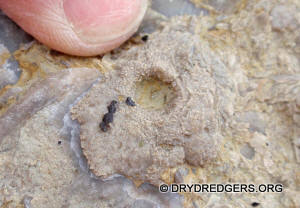


This crinoid holdfast is harder to identify.

Edrioasteroids (McMillan Formation)
Here's a story to tell. I was examining a crinoid holdfast
that a member had found on a brachiopod and while I had the loup to my eye I
quickly checked the other bumps on the Rafinesquina (first picture below). I saw this really tiny
thing that I looked like a baby Edrioasteroid.
It's really tiny - less than two millimeters wide. See the second photo below.
Judge for yourself. Nice!
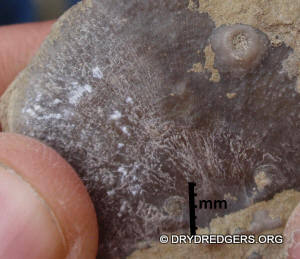
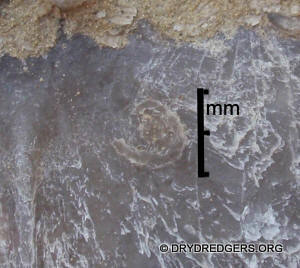
This got me going. Here's another brachiopod with bumps that
might be Edriosteroids. I saw this in
a photo I took of several Rafinesquina sp. brachiopods. So if you have a number
of brachiopods, examine them closely for tiny bumps like this. They could be the
best fossil find of your day.
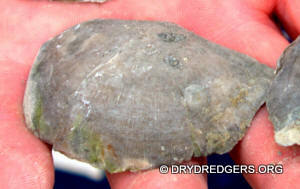
Nautiloid Cephalopods (McMillan Formation)
We found lots and lots of straight-shelled nautiloid
cephalopods at this site as well as the first site. The first specimen pictures
is incredible because it shows how calcite (white-ish color) has replaced the
smaller chambers but the larger ones are filled with uncrystalized sediment. It
also clearly shows the siphuncle which runs down the center. It's an excellent
specimen.

Here's something we've seen before. It's a segment in
cross-section of a nautiloid cephalopod encrusted with bryozoans. It forms a
nearly perfect circle, which is not the way we find cephalopods preserved
partially as internal molds. Awesome!
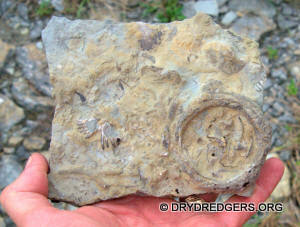
Brachiopods (McMillan Formation)
Rafinesquina sp.
Vinlandostrophia ponderosa
Inarticulate Brachiopods Trematis sp.
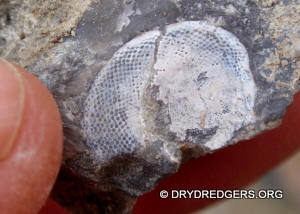
Many brachiopods of the McMillan formation are hollow inside,
making them excellent geodes filled with calcite crystals. (next 2 pics.)
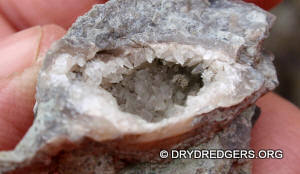

Pelecypods (clams) (McMillan Formation)
Gastropods (McMillan Formation)
Bryozoans (McMillan Formation)
Trace Fossils (McMillan Formation)
You can't say Dry Dredgers are not interested in arthropods
from all times. Here's a modern spider who kindly allowed us to collect fossils
on his/her territory. Thanks!

That's all for this field trip.
Now let's see photos of the Dry Dredgers at
Fossil Festival on October 17, 2015
Care to see photos of our previous picnic and joint field trips with the Kentucky Paleo Society?
2014: Hosted by KPS,
Mississippian of Central Kentucky
2013: Hosted by Dry Dredgers,
Richmondian of Brookville, Indiana
2012: Hosted by KPS, Ordovician and Silurian
of Bardstown, KY
2011: Hosted by Dry Dredgers, Richmondian of Brookville, Indiana
2010: Hosted by KPS, Ordovician and
Silurian of Bardstown, KY
2009: Hosted by Dry Dredgers, Maysvillian in
a Southern Ohio Creek Bed
2008: Hosted by KPS, Ordovician and Silurian
of Bardstown, KY
2004: Hosted by Dry Dredgers, Fairview Formation of Kentucky.
Back to the Field Trip Index Page
Return to Dry Dredgers Home Page
The Dry Dredgers and individual contributors reserve the
rights to all information, images, and content presented here. Permission to
reproduce in any fashion, must be requested in writing to admin@drydredgers.org.
www.drydredgers.org is designed and maintained by Bill Heimbrock.